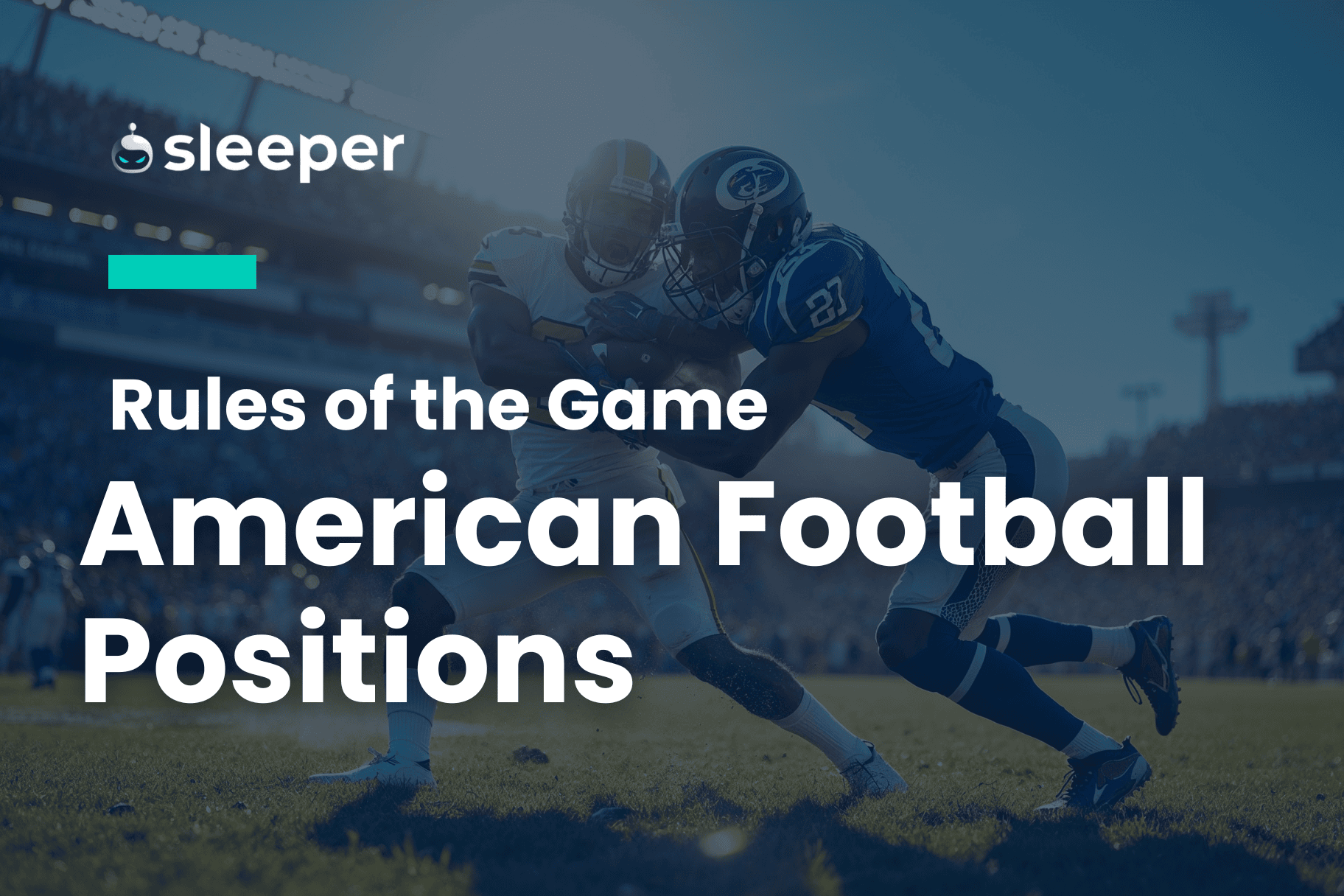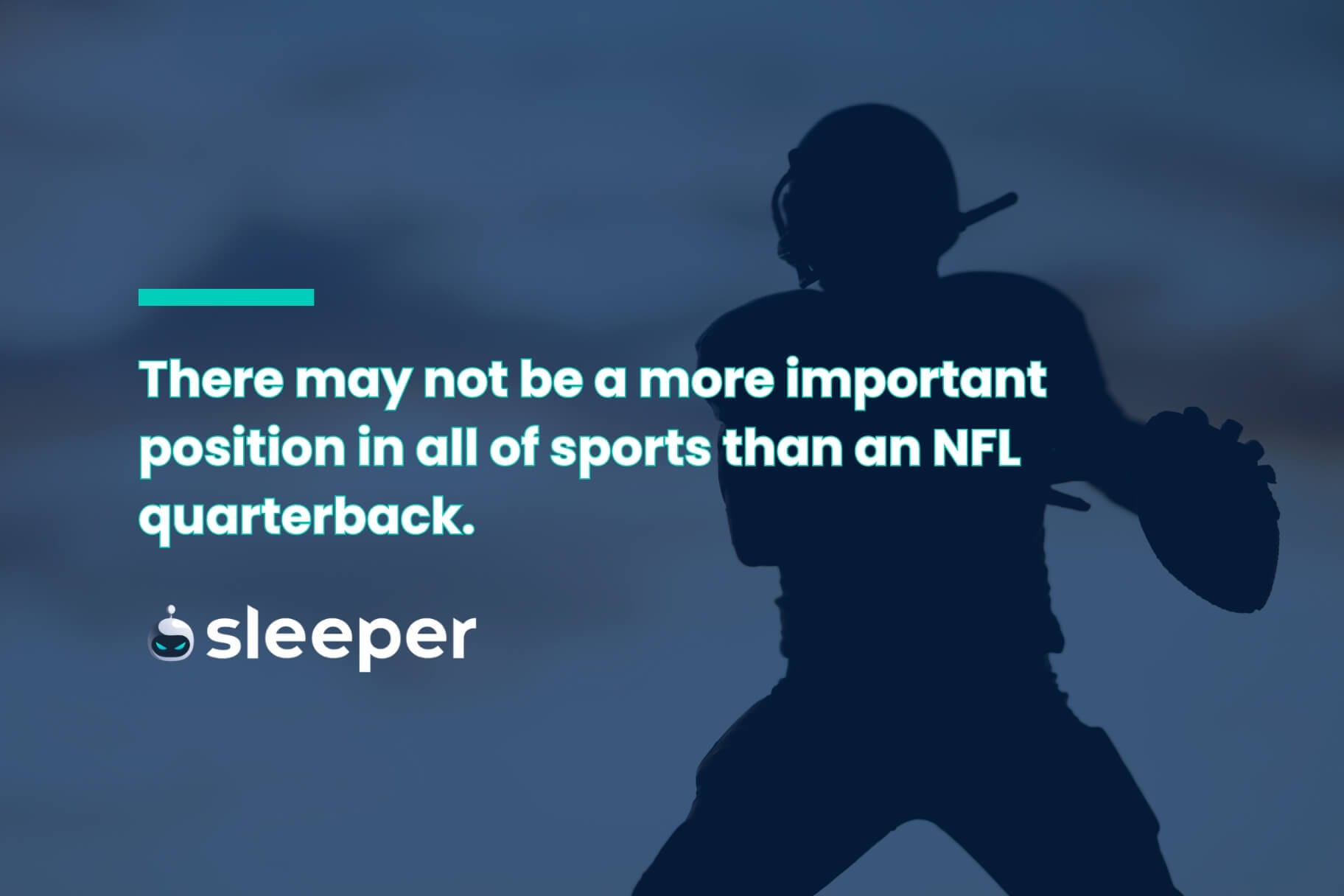Football can be a hard game to pick up if you’re new to the sport, but a good place to start is going position by position to cultivate your understanding.

If you’re new to watching the NFL or college football or any other league in America, it can be overwhelming. There are so many positions, rules and unique aspects that make it hard for nubies to follow.
In football, the easiest way to get started is to go position by position and get to know how things operate on offense and defense. So that’s what we’ll do to kick off this guide to the game and get you up to speed so you can watch with a greater appreciation and take your knowledge to the fantasy football landscape.
How Many Positions Are There in Football?
Let's start at the most basic level. On a given play, there are 22 players on the field — 11 on offense, 11 on defense; or 11 on the kicking team, 11 on the receiving team. But there is plenty of specialization beyond that, which we'll break down by looking at all three phases of the game: offense, defense and special teams.
Offense Positions in Football
Quarterback (QB)
There may not be a more important position in sports than an NFL quarterback. The QB (aside from the center, who hikes the ball), is the only offensive player to touch the ball on every play, and it’s his decision-making and ability to deliver under duress that makes or breaks a team’s fortunes.
Some QBs are pocket passers — meaning their mobility is limited but their ability to move within the pocket and navigate the pressure allows them to be prolific throwers — while others are running threats and keep defenses honest with their feet.
The best QBs can read defenses, adjust on the fly with audibles and have an almost telekinetic connection with their receivers — an understanding so deep that when a play breaks down they can stay on the same page and make the most of the situation.
Tom Brady, Joe Montana and John Elway are three of the best to ever do it at QB.

Running Back (RB)
Running backs take handoffs from QBs and frequently run out on pass plays to act as additional receivers, with the most dynamic ones commanding the attention of opposing defensive coordinators. RBs will also assist in pass protection when they’re not rushing the ball, given that they’re situated so close to the QB.
Jim Brown, Walter Payton, Emmitt Smith and Barry Sanders were among the greatest to rush the ball in NFL history.
Wide Receiver (WR)
Wideouts run routes and catch passes from QBs, but not all WRs are the same. Slot receivers are generally smaller and run shorter routes and operate in the middle of the field. “X” receivers are the big-play threats who gobble up the chunk plays down the field. “Z” receivers, who are also known as flankers, are do-it-all pass-catchers who run short and longer routes and help complement their teammates.
WRs are also tasked with blocking down the field, and for each other, on plays when their number is not called.
Jerry Rice, Randy Moss and Don Hutson span the generations to make up three of the greatest receivers in the game’s history.
Tight End (TE)
Tight ends are extensions of the offensive line, as they typically line up beside the tackles. But they are eligible to catch passes and are leaner and fleeter of foot. Their size and agility can make the best ones matchup nightmares for opposing defenses, and the most complete tight ends are also immense at blocking and take great pride in that aspect of the game.
Tony Gonzalez, Rob Gronkowski and Travis Kelce are all regularly considered to be among the best and most productive tight ends ever.
Fullback (FB)
This position is a bit of a dying breed, as not every team makes use of a regular fullback. But at their core, fullbacks do a ton of the dirty work, either serving as extra protection for quarterbacks or blocking and creating holes for running backs to stride through en route to a big gain. They’re also known to take inside handoffs in short-yardage or goal-line situations and sneak out for the occasional reception.
Baltimore’s Patrick Ricard and San Francisco’s Kyle Juszczyk are two of the more prominent ones in today’s NFL.
Tackles (LT and RT)
Tackles are invaluable assets to an offensive line considering how vital they are to protecting the quarterback. They generally line up against the best pass-rushers and have to be fast enough to keep up with them and big enough to manhandle them.
Left tackles, in particular, are seen as foundational components to a team, given that they protect a QB’s blind side (if he’s a right-handed thrower, as the vast majority of NFL QBs are).
Anthony Muñoz, Jonathan Ogden and Joe Thomas are three of the greatest tackles to ever suit up on an offensive line.
Guards (LG and RG)
Guards patrol the interior of the line, lining up on either side of the center. They’re charged with both run-blocking and pass-blocking, and they’ll coordinate on certain kinds of running plays to move from their original position and offer additional strength on the side to which the ball is going.
Bruce Matthews, John Hannah and Larry Allen were among the strongest and most stout interior linemen in league history.
Center (C)
The center snaps the ball to the QB on every offensive play, but he also directs plenty of traffic and is responsible for blocking along the interior of the offensive line. It’s a vastly underrated position, and if you have an elite one on your line, he can be the anchor of a solid unit.
Jason Kelce and Alex Mack were two of the best of the modern era, while Raiders Hall of Famer Jim Otto was chief among the greats of a previous generation.
Defense Positions in Football
Defensive Linemen (DE or DL)
The defensive line seeks to stop the run while also applying pressure to the quarterback. It’s a unit that is meant to disrupt the offense in the trenches, and if it can do so on its own, then that allows defensive coordinators to hold back on blitzing, which keeps more numbers back in coverage.
Defensive ends typically rush the passer with ferocity from the edges of the line and are matched up with the offensive tackles. Interior defensive linemen look to break through the heart of the offensive line and have a bigger hand in stopping the run, though they can get their fair share of sacks by overpowering their counterparts.
Aaron Donald, Reggie White and Bruce Smith tortured opposing offensive lines and QBs throughout their playing days.
Nose Tackle (NT)
Typically part of the DL, these beasts line up over the center but are also responsible for plugging the gaps and stuffing the run when opposing offenses try to run between the tackles. They eat space and absorb enough attention to open up room for their teammates to attack in the backfield.
Vince Wilfork, Ted Washington and Casey Hampton are three all-time greats.
Cornerback (CB)
Corners match up with the opposition’s wide receivers with an eye on shadowing them all over the field and playing lock-down defense to the point that no big plays or scoring plays materialize. They are often among the most athletic players on the field, as they have to keep up with speedy receivers and make acrobatic plays on balls in the air, while also having the ability to shed blockers and make tackles in the open space.
Some of the best to ever do it include Deion Sanders, Rod Woodson and Charles Woodson (no relation).

Linebacker (LB)
Linebackers tend to be the quarterbacks of the defense. They read the offensive formations, call out plays and are generally viewed as leaders of the team. They also deliver massive hits and patrol the center of the field — either as a spy to watch whatever the quarterback does, or by dropping into pass coverage on running backs and tight ends.
Lawrence Taylor, Ray Lewis and Dick Butkus are generally considered to be three of the hardest-hitting and most vicious linebackers in NFL history.
Safety (FS and SS)
There are free safeties and strong safeties, with the former typically patrolling deep and offering help over the top on longer pass players and the latter crashing the line to help stuff the run. They tend to be hard-hitting defenders and a hybrid of corners and linebackers — fast and small enough to run all over the field and help in coverage, but stout and strong enough to deliver big hits and break plays up.
Ronnie Lott, Brian Dawkins and Ed Reed are three of the best modern-era safeties and inspired fear in their opponents.
Special Teams Positions in Football
Kicker (K)
This player handles all extra point (point after touchdown) attempts and field goals and often finds himself in high-pressure situations with the game on the line. Kickers will usually handle kickoffs as well, though that is not always the case.
Adam Vinatieri, Justin Tucker and Morten Andersen rank tops among the all-time great kickers.
Punter (P)
When an offense is not close enough to attempt a field goal and either not bold enough or not realistically close enough to go for it on fourth down, the team will turn to its punter to kick the ball to the other team.
The punter’s job is to pin the opposition deep in its own end or, if he’s kicking from deep in his own territory, then at the very least reverse field position to give the defense a fighting chance at keeping the other team from scoring.
All-time punting greats include Ray Guy, Shane Lechler and Pat McAfee (yes, that Pat McAfee).
Long Snapper (LS)
Long snappers have one job, but it’s important: deliver the ball on the money to punters and holders so punts and field goals can go off without a hitch.
Long snappers are never noticed when they do their job correctly, but they’re always noticed when things go awry.
Gunner (G)
The gunner is the top dog on the punt coverage unit and often in the mix either making a tackle immediately after a punt is received or downing the ball where it lands.
Steve Tasker and Matthew Slater are two gunners whose consistency and longevity made them key assets to their teams.
Holder (H)
Often, the holder on a team is either the punter or a backup quarterback, but he has a pretty important job. Field goal kickers need to trust that their holders will get the timing right and handle any errant snap, and if holders can’t get the ball down with the laces spun out in time, then the whole kicking operation falls apart.
See also: What is Special Teams in Football?
How Positions Apply to Fantasy Football
In fantasy football, player stats equate to fantasy points, and you’ll want to get familiar with the best players at each of the offensive skill positions (QB, RB, WR, TE) at the very least. They’re the ones who will score the bulk of your points and determine the fate of your season.
Some leagues include individual defensive players (as opposed to the more streamlined team defense/special teams units), which would require you to get to know those on the other side of the ball as well.
But for the vast majority of fantasy players, you’re going to need to know the landscape of starting QBs across the NFL; you’re going to want to understand who the best running backs are and what it means to potentially draft their handcuffs; and you’ll certainly need to have an idea of who the best receivers and tight ends are, especially if you’re in a half-PPR or PPR league.
Going position-by-position and getting further acquainted with the tiers of players in each will only strengthen your ability as a fantasy manager.

Frequently Asked Questions
What’s the highest-paid position in football?
It should be no surprise that quarterbacks are the ones who make the most, especially at the top tier. Entering the 2024 season, multiple QBs averaged over $50 million a year and four have over $200 million in guaranteed money (in the NFL, guaranteed money matters infinitely more than the entirety of a deal, given how easily teams can cut players and wiggle out of contracts outside of what is guaranteed).
What’s the hardest position in football?
That’s a subjective question, and every positional coach would have an argument to make, but it has to be quarterback. The QB is the one who absorbs the most information and then has to disseminate it to the rest of the offense. He’s the one who is the chief link between the coaching staff and the team. He’s the one who is always front and center in the headlines, win or lose, and he’s the one who has to react in real time to the chaos that swirls on every offensive play.
There’s a reason top QB prospects are the most coveted players in the draft, and there’s a reason why the best QBs earn top dollar.
What’s the easiest position in football?
It’s the kicker or punter. It’s rare that they get hit or are forced to deliver a hit, they’re kicking specialists and their position requires the least amount of physical exertion. That doesn’t mean it’s easy, though. They often take the field in pressure-packed situations and absolutely need to deliver for their team. It’s easy to write off their utility, but it’s just as easy to throw them under the bus if their kicks go wrong.
Position yourself for fantasy football success with Sleeper
Now that you have a better handle on football positions, try your hand at a season-long fantasy football league with Sleeper. Positional rankings and mock drafts are readily available and accessible throughout the run-up to draft season, and you can customize your league in countless ways to craft the settings that you and your fellow league managers desire. Sign up on the website or by downloading the app, to get started.
You can also test your positional knowledge by playing daily fantasy sports (DFS) games with Sleeper such as Sleeper Picks, where you can maximize your winnings up to 100x by simply choosing whether you think players will exceed or fall short of their stat projections.




